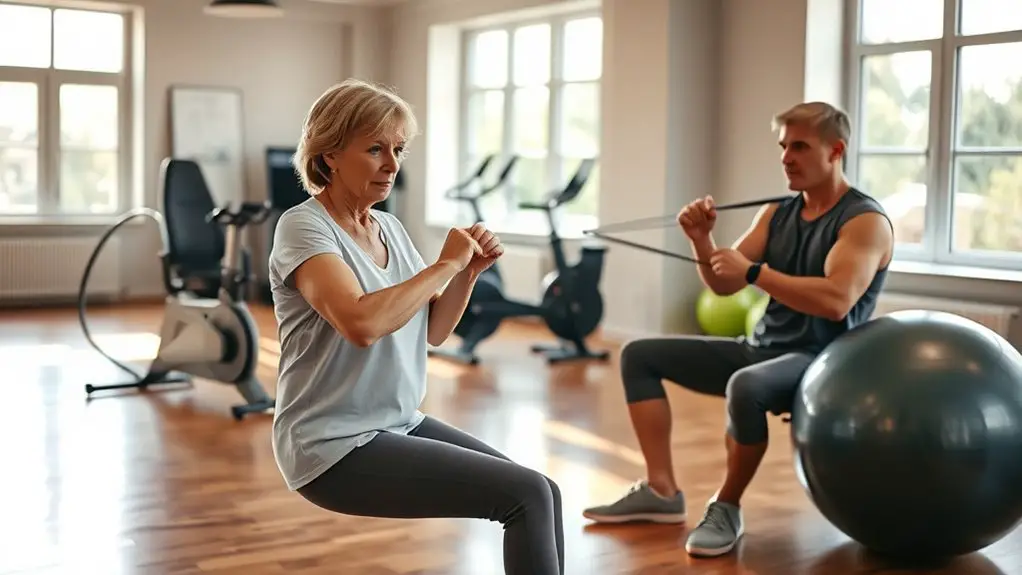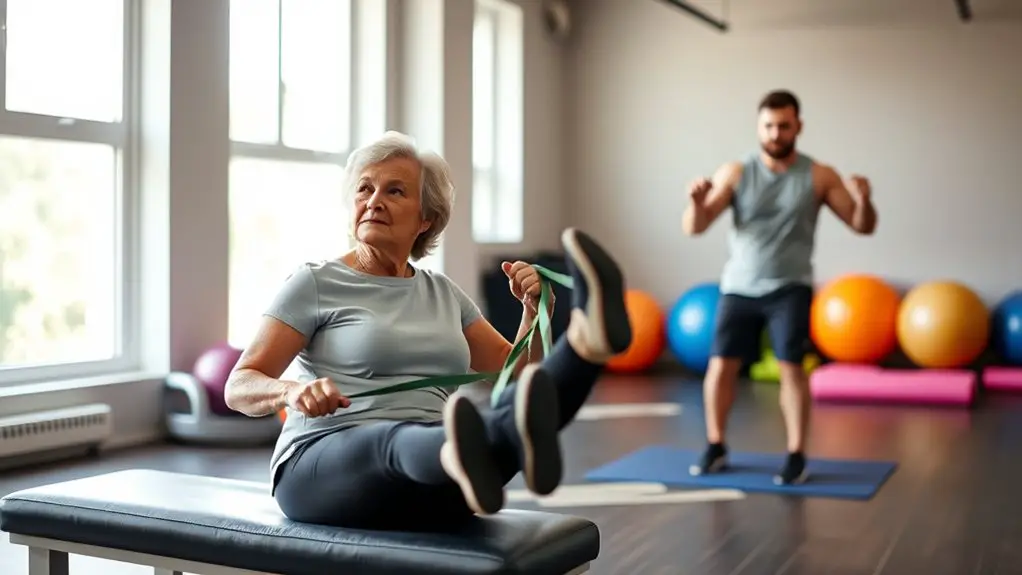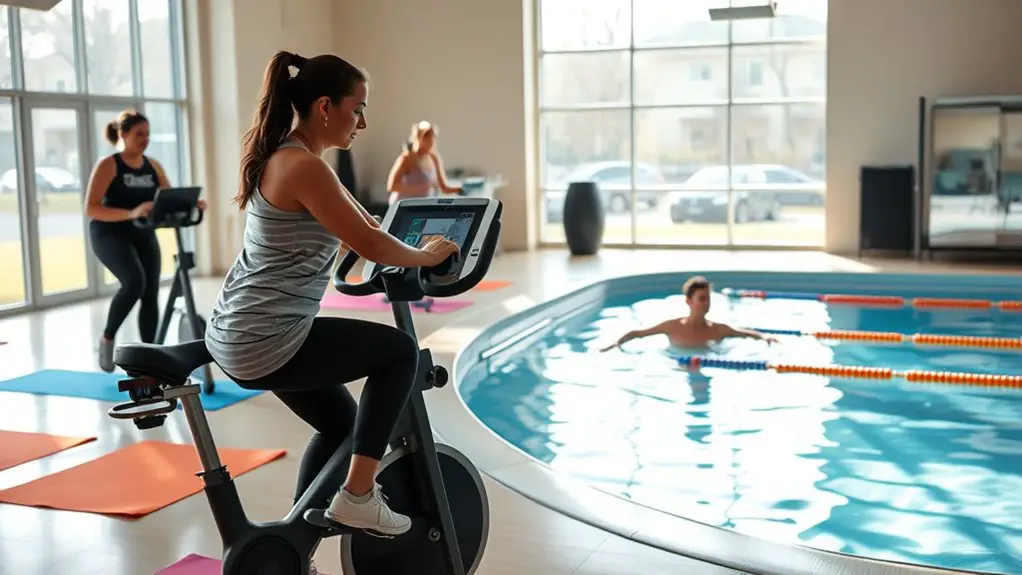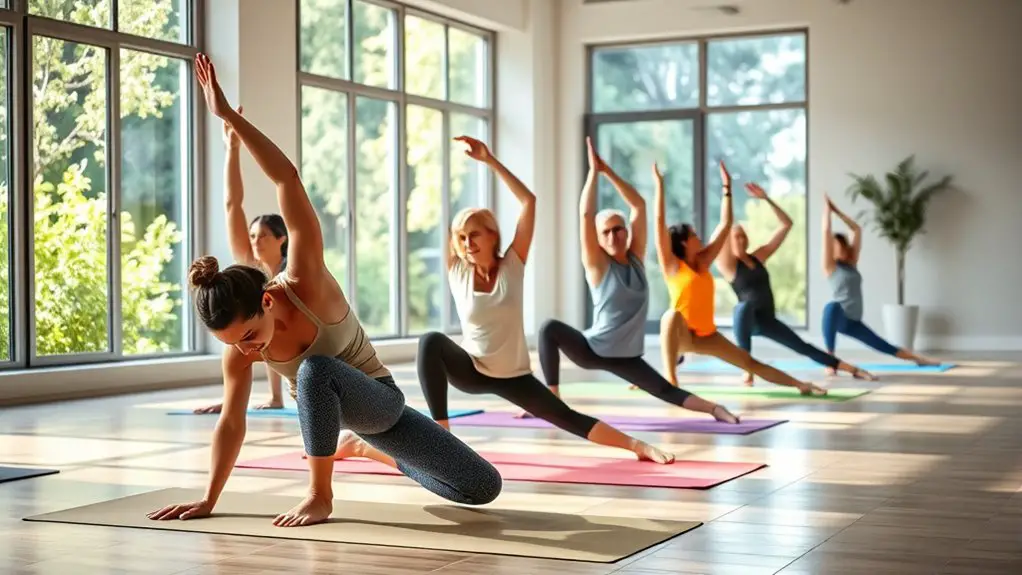The Best Gym Exercises for People With Arthritis

If you have arthritis, focus on low-impact cardio like stationary biking or elliptical machines to minimize joint strain. Strength training can help support your joints, starting with light resistance exercises. Don’t forget flexibility stretches, which ease stiffness and improve range of motion. Consider yoga or aquatic therapy for relaxation and gentle strengthening. Using resistance bands can also enhance your workouts safely. Keep going to discover more tailored tips for optimizing your fitness routine with arthritis.
Understanding Arthritis and Its Impact on Fitness

Arthritis, a condition marked by inflammation and pain in the joints, can considerably impact your ability to engage in physical activity. There are various types of arthritis, including osteoarthritis and rheumatoid arthritis, each with distinct characteristics and symptoms. Common arthritis symptoms often include joint stiffness, swelling, and a reduced range of motion, which can make even simple movements challenging.
These limitations can lead to feelings of frustration and helplessness, affecting not just your physical health but also your mental well-being. It is crucial to recognize how these symptoms can inhibit your fitness journey and daily activities. Understanding your specific type of arthritis can help you tailor your exercise routine appropriately. By addressing your unique symptoms and limitations, you can find ways to stay active while managing your condition effectively. Remember, you’re not alone in this journey, and there are strategies to help you maintain an active lifestyle despite arthritis.
Benefits of Exercise for Arthritis Sufferers
Exercise can be a powerful tool for managing arthritis symptoms. Engaging in regular physical activity not only helps alleviate pain but also enhances joint flexibility, allowing for improved mobility in daily life. By incorporating exercise into your routine, you may find a significant reduction in discomfort and an increase in your overall quality of life.
Pain Relief and Management
When managing arthritis, incorporating regular physical activity can greatly alleviate pain and improve overall joint function. Exercise plays a vital role in pain management, helping you build strength and endurance while promoting flexibility. Even small lifestyle adjustments, like including gentle exercises, can make a significant difference in how you feel daily.
| Exercise Type | Benefits | Frequency |
|---|---|---|
| Aerobic | Increases blood flow | 3-5 times/week |
| Strength Training | Builds joint-supporting muscles | 2-3 times/week |
| Flexibility | Enhances range of motion | Daily |
| Balance | Reduces fall risk | 2-3 times/week |
Improved Joint Flexibility
Maintaining joint flexibility is crucial for anyone managing arthritis, as stiffness can greatly hinder daily activities. Incorporating dynamic stretching into your routine can markedly enhance joint mobility. These stretches involve controlled movements that gently warm up your muscles and joints, promoting better range of motion. Engaging in regular exercise not only helps reduce stiffness but also improves circulation, which is essential for joint health. As you gradually increase your flexibility, you may notice an improvement in your ability to perform daily tasks with less discomfort. Remember, it’s important to listen to your body and start slowly, progressively increasing the intensity of your exercises. This approach can lead to long-term benefits in managing arthritis and enhancing your overall quality of life.
Low-Impact Cardio Exercises

Low-impact cardio exercises are essential for individuals with arthritis, as they help improve cardiovascular health without putting excessive strain on the joints. Engaging in activities like stationary biking and using elliptical machines can be particularly beneficial. These options provide a smooth, gentle motion that minimizes the impact on your joints while still elevating your heart rate.
When you incorporate stationary biking into your routine, you can adjust the resistance to match your comfort level, allowing for a personalized workout. Similarly, elliptical machines offer the advantage of a full-body workout without the jarring effect of running or jogging.
Aim for 20 to 30 minutes of low-impact cardio several times a week. This not only enhances your endurance but also contributes to weight management, which can relieve additional pressure on your joints. Always consult with your healthcare provider before starting any new exercise program to guarantee it’s appropriate for your condition.
Strength Training for Joint Support
Although it may seem counterintuitive, strength training can be incredibly beneficial for individuals with arthritis, as it helps build and maintain the muscles that support your joints. By enhancing joint stability, you can reduce pain and improve overall function. Start with low-resistance exercises and gradually increase as your strength improves. It’s important to consider low-impact exercises to complement your strength training routine, especially if you experience discomfort.
Here’s a table outlining some effective strength training exercises:
| Exercise | Benefits |
|---|---|
| Leg Press | Strengthens lower body muscles |
| Seated Row | Enhances upper back strength |
| Chest Press | Builds chest and shoulder muscles |
| Dumbbell Curls | Strengthens arms |
| Bodyweight Squats | Improves leg strength and stability |
Always consult with a healthcare professional before starting a new routine. The goal is to promote strength while minimizing discomfort, allowing you to engage in daily activities with greater ease and confidence.
Flexibility and Stretching Exercises

Maintaining flexibility is essential for managing arthritis, as it helps reduce stiffness and improve your range of motion. Incorporating recommended stretching techniques into your routine can greatly enhance your overall mobility and comfort. It’s important to reflect on how often and how long you should stretch to maximize these benefits safely.
Importance of Flexibility
Flexibility plays an essential role in managing arthritis, as it helps maintain joint function and reduce stiffness. Incorporating flexibility exercises into your routine can greatly enhance your mobility and overall quality of life. Here are some key benefits of focusing on flexibility:
- Improved range of motion: Essential for performing daily activities.
- Reduced pain: Stretching may alleviate discomfort associated with stiffness.
- Enhanced circulation: Promotes blood flow to joints and muscles.
- Injury prevention: Increased flexibility may lower the risk of strains.
- Better posture: Helps in maintaining proper alignment, reducing strain on joints.
Both dynamic stretching and static stretching can be beneficial. By committing to a regular flexibility routine, you can take significant steps toward managing your arthritis effectively.
Recommended Stretching Techniques
Many individuals with arthritis find that incorporating targeted stretching techniques can greatly improve their mobility and comfort. Dynamic stretches, performed gently, can warm up your joints and prepare them for activity. Simple movements, like arm circles or leg swings, help increase blood flow without straining your muscles. On the other hand, static stretches are essential for maintaining flexibility. Holding stretches, such as a gentle hamstring stretch, for about 15-30 seconds can enhance joint range of motion and alleviate stiffness. Always listen to your body and avoid pushing into pain. These stretching techniques, when practiced consistently, can not only enhance your physical function but also contribute to your overall well-being. Prioritize your comfort as you work on these essential exercises.
Frequency and Duration
Incorporating stretching exercises into your routine two to three times a week can considerably enhance your mobility and joint function. To maximize benefits, focus on both exercise frequency and workout duration. Aim for sessions lasting 15 to 30 minutes, ensuring you’re gentle with your body.
- Start with light warm-ups to prepare your muscles.
- Hold each stretch for 15-30 seconds to promote flexibility.
- Listen to your body; avoid pushing through pain.
- Gradually increase the intensity of your stretches as you progress.
- Consider integrating deep breathing techniques to reduce tension.
Water Aerobics and Aquatic Therapy

Water aerobics and aquatic therapy offer a low-impact alternative for individuals with arthritis, allowing you to engage in exercise while minimizing stress on your joints. The buoyancy of water benefits your body by reducing the impact on painful areas, making it easier to perform movements that might otherwise cause discomfort. Aquatic exercises can improve strength, flexibility, and cardiovascular health, all essential for managing arthritis symptoms.
In a warm pool, you’ll find that resistance from water enhances your workout without adding strain. Exercises like water walking, leg lifts, and gentle stretches can be performed with minimal risk of injury. Additionally, the soothing properties of water can help alleviate pain and stiffness, promoting relaxation. Regular participation in water-based activities not only aids physical well-being but can also enhance your mood, providing a holistic approach to arthritis management. Embrace these aquatic options for a healthier, more active lifestyle.
Yoga and Pilates for Arthritis Relief
While aquatic activities provide a gentle way to stay active, yoga and Pilates also offer significant benefits for those living with arthritis. These practices incorporate gentle stretches and mindful breathing, promoting flexibility and relaxation. They can help alleviate pain, improve mobility, and foster a sense of overall well-being.
Benefits of yoga and Pilates for arthritis relief include:
- Enhanced flexibility through controlled movements
- Improved strength in supportive muscle groups
- Reduced stress and anxiety via mindful breathing
- Greater body awareness, helping to prevent injuries
- Increased range of motion, easing joint stiffness
Engaging in these low-impact exercises can empower you to manage your symptoms effectively. Remember to listen to your body, modify poses as needed, and consult a healthcare professional before starting any new routine. With consistent practice, you may find relief and greater ease in your daily activities.
Using Resistance Bands Safely

How can you safely incorporate resistance bands into your exercise routine if you have arthritis? First, choose high-quality resistance bands that offer a range of resistance levels, allowing you to gradually increase intensity without straining your joints. Start with light resistance and focus on controlled movements to guarantee safe usage. It’s essential to maintain proper form; avoid jerky motions that could exacerbate pain.
Incorporate exercises that target major muscle groups while keeping your joints stable. For instance, seated rows or leg presses can be effective. Always listen to your body—if you experience discomfort, stop the exercise and reassess your technique or resistance level.
Lastly, consider consulting with a physical therapist to tailor your resistance band workouts, making sure they’re appropriate for your specific limitations and needs. By prioritizing safety, you can enjoy the benefits of resistance training while managing arthritis effectively.
Tips for Creating a Personalized Workout Routine
Creating a personalized workout routine is essential for managing arthritis effectively, especially since individual needs can vary widely. To guarantee your routine aligns with your personal goals and workout preferences, consider the following tips:
Creating a tailored workout plan is vital for effective arthritis management, considering individual needs and preferences.
- Assess your current fitness level: Understand your strengths and limitations to craft a safe routine.
- Set realistic goals: Focus on manageable objectives that encourage consistency without causing strain.
- Incorporate variety: Mix low-impact exercises, such as swimming or cycling, with strength training to keep your routine engaging.
- Listen to your body: Pay attention to how your joints respond to different activities and adjust accordingly.
- Schedule regular check-ins: Periodically evaluate your progress and make necessary modifications to stay motivated.
When to Seek Professional Guidance

Knowing when to seek professional guidance can greatly impact your ability to manage arthritis effectively. If you experience signs of discomfort during exercise, it’s essential to consult a healthcare professional. Pain that’s persistent or worsens over time may indicate that your current routine isn’t suitable for your condition.
Additionally, if you’re unsure about which exercises are safe or beneficial, seeking professional recommendations from a physical therapist or a trained fitness coach can help tailor your regimen. They can provide insights on proper techniques, modifications, and alternative exercises that minimize strain on your joints.
Frequently Asked Questions
Can I Exercise During an Arthritis Flare-Up?
Yes, you can exercise during an arthritis flare-up, but it’s essential to approach it cautiously. Focus on gentle movements that promote flare-up management and pain relief, like stretching or low-impact activities. Listen to your body; if something hurts, it’s best to stop. Consulting with a healthcare professional can help tailor an exercise routine that suits your needs, ensuring you stay active while minimizing discomfort during these challenging times.
What Type of Shoes Are Best for Exercising With Arthritis?
Did you know that nearly 54 million adults in the U.S. are affected by arthritis? When choosing shoes for exercising with arthritis, look for supportive footwear with features like cushioning, arch support, and a wide toe box. These elements help reduce stress on your joints and enhance comfort. Proper footwear can make a significant difference in your ability to stay active while managing your condition, so prioritize comfort and support in your choices.
How Long Should I Exercise Each Day?
When considering exercise duration, it’s typically recommended that you aim for at least 30 minutes a day. However, it’s important to listen to your body and adjust based on how you feel. You might break this into shorter segments, especially if you’re incorporating it into your daily routine. Consistency is key, so find a balance that works for you, ensuring you feel comfortable while reaping the benefits of regular exercise.
Are There Specific Exercises to Avoid With Arthritis?
Did you know that over 54 million adults in the U.S. suffer from arthritis? When managing arthritis, it’s essential to avoid high-impact exercises that can worsen joint pain. Instead, focus on low-impact activities like swimming or cycling, which can help maintain fitness without strain. Flexibility training is also important; gentle stretches can improve mobility and reduce stiffness. Always listen to your body and consult a healthcare professional before starting any new exercise routine.
Can I Use Gym Machines if I Have Arthritis?
Yes, you can use gym machines if you have arthritis, but machine safety is vital. It’s important to choose machines that allow for controlled movements and support your joints. Consider using adaptive techniques, like adjusting the weight or range of motion to suit your comfort level. Always listen to your body, and consult a healthcare professional before beginning any new exercise routine to guarantee it’s safe and effective for your specific condition.





